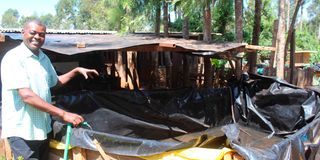Physics of fish farming

Livingstone Waithaka at his farm in Ithenguri village, Nyeri County. The technician, who once was a poultry farmer, has devised a system that uses sawdust to heat water, increasing his catfish's survival rate.
Water is draining into freshly constructed ponds with thousands of catfish fingerlings a few metres from the entrance of Livingstone Waithaka’s home in Ithenguri village, Nyeri County.
It is hard to make much of why a solar system atop the roof, underneath piping, a boiler wafting some smoke and a temperature recording system with red and green wires are stationed near the ponds.
But Waithaka, a technician, is doing all these to cut down on the cost of producing fish and maximising harvests.
Waithaka is holding a plastic container full of pellets when we approach him.
He is getting the feeds from a sack nearby and dropping the pellets in the seven ponds of different sizes that are next to one another. Waithaka started the farm last year after buying fingerlings in Kiambu County.
After several trips to Thika, he realised he was operating at a loss and needed to make some changes.
“The fish were dying or taking long to mature due to the cold water in Nyeri. I had to do something to reverse the trend,” he says.
Years ago, Waithaka had a poultry farm and relied on solar-powered incubators to hatch his chicks.
He stopped rearing chickens when the venture began making huge losses.
Waithaka has made improvement on the solar-powered system to run the fish hatchery and farm.
The system Waithaka refers to as reflex multi-thermic nidus uses different methods of heating that are normally automatically controlled.
It is all connected to the boiler, the solar underground water system that circulates the water and the temperature-recording gadget.
“The water getting into the pond cannot be more than 29 degrees Celsius. When the water gets too warm, the boiler automatically turns off. When it senses the pond water is getting too cold, it turns on,” the fish farmer says.
Waithaka adds that the boiler uses sawdust to run. He says sawdust burns for a long time.
To survive and achieve the right weight, catfish require a temperature of 26 to 33 degrees Centigrade.
Anything below that decreases their growth rate.
“My fish no longer die because of this system,” Waithaka tells Seeds of Gold.
His catfish fish are fed twice a day – in the morning and evening.
It takes nine to 10 months for catfish to mature and attain the preferred weight for sale and consumption.
Waithaka has not had any formal training on fish rearing but his love for physics drives him to come up with projects through experiments with as many gadgets as he can lay hands on.
“I think of how something can work better if I make improvements. I reinforce whatever comes into mind with action. It is all in the head,” he says.
He adds that modifying what is already in the market can improve the livelihoods of farmers in rural Kenya.
The biggest problem with such innovations, he says, is cost.
“I have used locally available materials. My system allows a farmer in a village that has no electricity to run a fish farm effectively and almost effortlessly. It should be taken into account that electricity costs are going up almost daily,” he says.
Next to the main pond is a wooden building that acts as the hatchery.
“I source a mature male and female catfish for breeding. I slice the female to remove the eggs and the male to get the gonads. I lay them on a mesh tray for 24 hours to get the fish fly which matures into fingerlings in a month or a month and a half,” he says.
Farmers’ workshops and training programmes have given Waithaka a lot of knowledge on fish rearing.
Some of the training is outside Kenya.
Apart from ensuring the fish are well fed to attain the required weight for the market, Waithaka says farmers must maintain hygiene – emptying the water and cleaning the ponds every month.
He sells a fingerling for Sh10 and Sh12, depending on size.
“The market is very big but supply is low. There is a high demand for white meat. The good news is that many people in Mt Kenya are now eating fish,” he says.
The cost of feeds has been one of the biggest challenges facing fish farmers, including Waithaka. Extreme temperatures can also be catastrophic.





